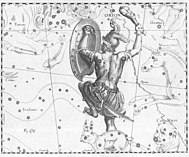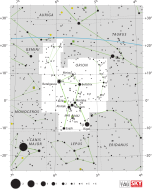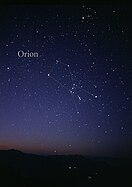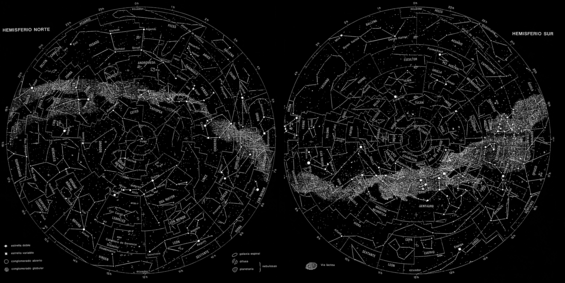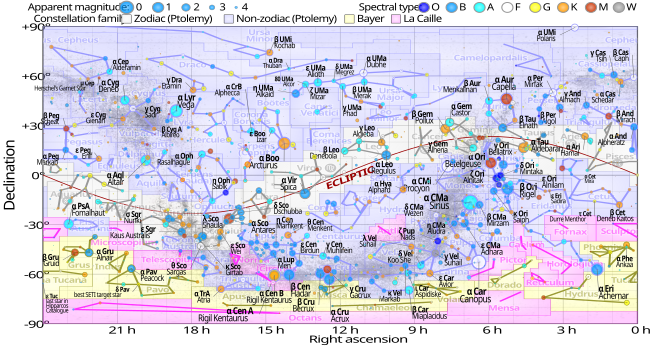Constellation
Four views of the constellationOrion:
- Top: Baroque drawing of Orion fromJohannes Hevelius'star atlasFirmamentum Sobiescianum,showing the stars as they would appear to an observer looking down upon the imaginary celestial sphere from the outside (left); and illustration from the medieval Persian astronomical textBook of Fixed Stars(right)
- Bottom: Contemporary map of Orion from theIAU(left); and photograph of the night sky with drawn lines (right)
Aconstellationis an area on thecelestial spherein which a group of visiblestarsformsa perceived patternor outline, typically representing an animal, mythological subject, or inanimate object.[1]
The first constellations likely go back toprehistory.People used them to relate stories of their beliefs, experiences,creation,mythology.Different cultures and countries invented their own constellations, some of which lasted into the early 20th century before today's constellations were internationally recognized. The recognition of constellations has changed significantly over time. Many changed in size or shape. Some became popular, only to drop into obscurity. Some were limited to a single culture or nation. Naming constellations also helped astronomers and navigators identify stars more easily.[2]
Twelve (or thirteen) ancient constellations belong to thezodiac(straddling theecliptic,which theSun,Moon,andplanetsall traverse). The origins of the zodiac remain historically uncertain; itsastrologicaldivisions became prominentc.400 BC inBabylonianorChaldeanastronomy.[3]Constellations appear in Western culture via Greece and are mentioned in the works ofHesiod,EudoxusandAratus.The traditional 48 constellations, consisting of the zodiac and 36 more (now 38, following the division ofArgo Navisinto three constellations) are listed byPtolemy,a Greco-Roman astronomer fromAlexandria,Egypt, in hisAlmagest.The formation of constellations was the subject of extensivemythology,most notably in theMetamorphosesof the Latin poetOvid.Constellations in the farsouthern skywere added from the 15th century until the mid-18th century when European explorers began traveling to theSouthern Hemisphere.Due to Roman and European transmission, each constellation has a Latin name.
In 1922, theInternational Astronomical Union(IAU) formally accepted the modern list of88 constellations,and in 1928 adopted official constellation boundaries that together cover the entire celestial sphere.[4][5]Any given point in acelestial coordinate systemlies in one of the modern constellations. Someastronomical naming systemsinclude the constellation where a given celestial object is found to convey its approximate location in the sky. TheFlamsteed designationof a star, for example, consists of a number and the genitive form of the constellation's name.
Other star patterns or groups calledasterismsare not constellations under the formal definition, but are also used by observers to navigate the night sky. Asterisms may be several stars within a constellation, or they may share stars with more than one constellation. Examples of asterisms include the teapot within the constellationSagittarius,or thebig dipperin the constellation ofUrsa Major.[6][7]
Terminology[edit]
The wordconstellationcomes from theLate Latintermcōnstellātiō,which can be translated as "set of stars"; it came into use inMiddle Englishduring the 14th century.[8]TheAncient Greekword for constellation isἄστρον(astron). These terms historically referred to any recognisable pattern of stars whose appearance was associated with mythological characters or creatures, earthbound animals, or objects.[1]Over time, among European astronomers, the constellations became clearly defined and widely recognised. In the 20th century, theInternational Astronomical Union(IAU) recognized88 constellations.[9]
A constellation or star that never sets below thehorizonwhen viewed from a particularlatitudeon Earth is termedcircumpolar.From theNorth PoleorSouth Pole,all constellations south or north of thecelestial equatorarecircumpolar.Depending on the definition, equatorial constellations may include those that lie between declinations 45° north and 45° south,[10]or those that pass through the declination range of theecliptic(orzodiac) ranging between23.5° northand23.5° south.[11][12]
Stars in constellations can appear near each other in the sky, but they usually lie at a variety of distances away from the Earth. Since each star has its own independent motion, all constellations will change slowly over time. After tens to hundreds of thousands of years, familiar outlines will become unrecognizable.[13]Astronomers can predict the past or future constellation outlines by measuringcommon proper motionsof individual stars[14]by accurateastrometry[15][16]and theirradial velocitiesbyastronomical spectroscopy.[17]
The 88 constellations recognized by the IAU as well as those by cultures throughout history are imagined figures and shapes derived from the patterns of stars in the observable sky.[18]Many officially recognized constellations are based on the imaginations of ancient, Near Eastern and Mediterranean mythologies.[19][20]Some of these stories seem to relate to the appearance of the constellations, e.g. the assassination ofOrionby Scorpius, their constellations appearing at opposite times of year.[21]
Observation[edit]
Constellation positions change throughout the year due tonighton Earth occurring at gradually different portions ofits orbitaround the Sun. AsEarth rotatestoward the east, thecelestial sphereappears to rotate west, with stars circling counterclockwise around the northernpole starand clockwise around the southern pole star.[22]
Because of Earth's 23.5°axial tilt,the zodiac is distributed equally across hemispheres (along the ecliptic), approximating agreat circle.Zodiacal constellations of the northern sky arePisces,Aries,Taurus,Gemini,Cancer,andLeo.In the southern sky areVirgo,Libra,Scorpius,Sagittarius,Capricornus,andAquarius.[23][a]The zodiac appears directly overhead from latitudes of 23.5° north to 23.5° south, depending on the time of year. In summer, the ecliptic appears higher up in the daytime and lower at night, while in winter the reverse is true, for both hemispheres.
Due to theSolar System's 60° tilt, thegalactic planeof theMilky Wayis inclined 60° from the ecliptic,[24]between Taurus and Gemini (north) and Scorpius and Sagittarius (south and near which theGalactic Centercan be found).[23]The galaxy appears to pass throughAquila(near the celestial equator) and northern constellationsCygnus,Cassiopeia,Perseus,Auriga,andOrion(nearBetelgeuse), as well asMonoceros(near the celestial equator), and southern constellationsPuppis,Vela,Carina,Crux,Centaurus,Triangulum Australe,andAra.[23]
Northern hemisphere[edit]
Polaris,being the North Star, is the approximate center of the northern celestial hemisphere. It is part ofUrsa Minor,constituting the end of the Little Dipper's handle.[23]
From latitudes of around 35° north, in January,Ursa Major(containing theBig Dipper) appears to the northeast, while Cassiopeia is the northwest. To the west are Pisces (above the horizon) and Aries. To the southwestCetusis near the horizon. Up high and to the south are Orion and Taurus. To the southeast above the horizon isCanis Major.Appearing above and to the east of Orion isGemini:also in the east (and progressively closer to the horizon) are Cancer and Leo. In addition to Taurus, Perseus and Auriga appear overhead.[23]
From the same latitude, in July, Cassiopeia (low in the sky) andCepheusappear to the northeast. Ursa Major is now in the northwest.Boötesis high up in the west. Virgo is to the west, with Libra southwest and Scorpius south. Sagitarrius and Capricorn are southeast. Cygnus (containing theNorthern Cross) is to the east.Herculesis high in the sky along withCorona Borealis.[23]
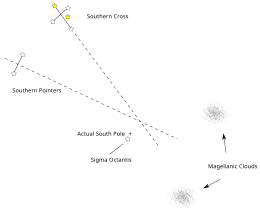
Southern hemisphere[edit]
January constellations includePictorandReticulum(near Hydrus and Mensa, respectively).[25]
In July, Ara (adjacent to Triangulum Australe) and Scorpius can be seen.[26]
Constellations near the pole star includeChamaeleon,Apusand Triangulum Australe (near Centaurus),Pavo,Hydrus,andMensa.
Sigma Octantisis the closest star approximating a southern pole star, but is faint in the night sky. Thus, the pole can be triangulated using the constellation Crux as well as the starsAlphaandBeta Centauri(about 30° counterclockwise from Crux) of the constellation Centaurus (arching over Crux).[23]
History of the early constellations[edit]
Lascaux Caves, southern France[edit]
It has been suggested that the 17,000-year-oldcave paintingsinLascaux,southern France, depict star constellations such as Taurus, Orion's Belt, and the Pleiades. However, this view is not generally accepted among scientists.[27][28]
Mesopotamia[edit]
Inscribed stones and clay writing tablets fromMesopotamia(in modern Iraq) dating to 3000 BC provide the earliest generally accepted evidence for humankind's identification of constellations.[29]It seems that the bulk of the Mesopotamian constellations were created within a relatively short interval from around 1300 to 1000 BC. Mesopotamian constellations appeared later in many of the classical Greek constellations.[30]
Ancient Near East[edit]

The oldestBabylonian cataloguesof stars and constellations date back to the beginning of theMiddle Bronze Age,most notably theThree Stars Eachtexts and theMUL.APIN,an expanded and revised version based on more accurate observation from around 1000 BC. However, the numerousSumerian namesin these catalogues suggest that they built on older, but otherwise unattested,Sumeriantraditions of theEarly Bronze Age.[31]
The classical Zodiac is a revision ofNeo-Babylonianconstellations from the 6th century BC. The Greeks adopted the Babylonian constellations in the 4th century BC. Twenty Ptolemaic constellations are from the Ancient Near East. Another ten have the same stars but different names.[30]
Biblical scholarE. W. Bullingerinterpreted some of the creatures mentioned in the books ofEzekielandRevelationas the middle signs of the four-quarters of the Zodiac,[32][33]with the Lion asLeo,the Bull asTaurus,the Man representingAquarius,and the Eagle standing in forScorpio.[34]The biblicalBook of Jobalso makes reference to a number of constellations, includingעיש‘Ayish"bier",כסילchesil"fool" andכימהchimah"heap" (Job 9:9, 38:31–32), rendered as "Arcturus, Orion and Pleiades" by theKJV,but‘Ayish"the bier" actually corresponding to Ursa Major.[35]The termMazzarothמַזָּרוֹת,translated asa garland of crowns,is ahapax legomenonin Job 38:32, and it might refer to the zodiacal constellations.
Classical antiquity[edit]
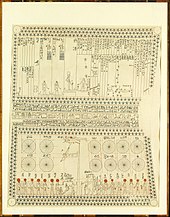
There is only limited information on ancient Greek constellations, with some fragmentary evidence being found in theWorks and Daysof the Greek poetHesiod,who mentioned the "heavenly bodies".[36]Greek astronomy essentially adopted the older Babylonian system in theHellenistic era,[citation needed]first introduced to Greece byEudoxus of Cnidusin the 4th century BC. The original work of Eudoxus is lost, but it survives as a versification byAratus,dating to the 3rd century BC. The most complete existing works dealing with the mythical origins of the constellations are by the Hellenistic writer termedpseudo-Eratosthenesand an early Roman writer styled pseudo-Hyginus.The basis of Western astronomy as taught duringLate Antiquityand until theEarly Modern periodis theAlmagestbyPtolemy,written in the 2nd century.
In thePtolemaic Kingdom,native Egyptiantradition of anthropomorphic figures represented the planets, stars, and various constellations.[37]Some of these were combined with Greek and Babylonian astronomical systems culminating in theZodiac of Dendera;it remains unclear when this occurred, but most were placed during the Roman period between 2nd to 4th centuries AD. The oldest known depiction of the zodiac showing all the now familiar constellations, along with some original Egyptian constellations,decans,andplanets.[29][38]Ptolemy'sAlmagestremained the standard definition of constellations in the medieval period both in Europe and inIslamic astronomy.
Ancient China[edit]

Ancient Chinahad a long tradition of observing celestial phenomena.[39]NonspecificChinese star names,later categorized in thetwenty-eight mansions,have been found onoracle bonesfromAnyang,dating back to the middleShang dynasty.Theseconstellationsare some of the most important observations of Chinese sky, attested from the 5th century BC. Parallels to the earliest Babylonian (Sumerian) star catalogues suggest that the ancient Chinese system did not arise independently.[40]
Three schools of classicalChinese astronomyin theHan periodare attributed to astronomers of the earlierWarring States period.The constellations of the three schools were conflated into a single system byChen Zhuo,an astronomer of the 3rd century (Three Kingdoms period). Chen Zhuo's work has been lost, but information on his system of constellations survives inTang periodrecords, notably byQutan Xida.The oldest extant Chinese star chart dates to that period and was preserved as part of theDunhuang Manuscripts.Native Chinese astronomy flourished during theSong dynasty,and during theYuan dynastybecame increasingly influenced bymedieval Islamic astronomy(seeTreatise on Astrology of the Kaiyuan Era).[40]As maps were prepared during this period on more scientific lines, they were considered as more reliable.[41]
A well-known map from the Song period is theSuzhou Astronomical Chart,which was prepared with carvings of stars on theplanisphereof the Chinese sky on a stone plate; it is done accurately based on observations, and it shows the supernova of the year of 1054 in Taurus.[41]
Influenced by European astronomy during the lateMing dynasty,charts depicted more stars but retained the traditional constellations. Newly observed stars were incorporated as supplementary to old constellations in the southern sky, which did not depict the traditional stars recorded by ancient Chinese astronomers. Further improvements were made during the later part of the Ming dynasty byXu GuangqiandJohann Adam Schall von Bell,the German Jesuit and was recorded inChongzhen Lishu(Calendrical Treatise ofChongzhen period,1628).[clarification needed]Traditional Chinese star maps incorporated 23 new constellations with 125 stars of the southern hemisphere of the sky based on the knowledge of Western star charts; with this improvement, the Chinese Sky was integrated with the World astronomy.[41][42]
Early modern astronomy[edit]
Historically, the origins of the constellations of the northern and southern skies are distinctly different. Most northern constellations date to antiquity, with names based mostly on Classical Greek legends.[11]Evidence of these constellations has survived in the form ofstar charts,whose oldest representation appears on the statue known as theFarnese Atlas,based perhaps on the star catalogue of the Greek astronomerHipparchus.[43]Southern constellations are more modern inventions, sometimes as substitutes for ancient constellations (e.g.Argo Navis). Some southern constellations had long names that were shortened to more usable forms; e.g. Musca Australis became simply Musca.[11]
Some of the early constellations were never universally adopted. Stars were often grouped into constellations differently by different observers, and the arbitrary constellation boundaries often led to confusion as to which constellation a celestial object belonged. Before astronomers delineated precise boundaries (starting in the 19th century), constellations generally appeared as ill-defined regions of the sky.[44]Today they now follow officially accepted designated lines ofright ascensionanddeclinationbased on those defined byBenjamin Gouldinepoch1875.0 in his star catalogueUranometria Argentina.[45]
The 1603 star atlas "Uranometria"ofJohann Bayerassigned stars to individual constellations and formalized the division by assigning a series of Greek and Latin letters to the stars within each constellation. These are known today asBayer designations.[46]Subsequent star atlases led to the development of today's accepted modern constellations.
Origin of the southern constellations[edit]
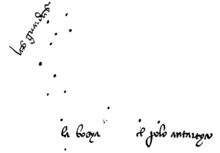

The southern sky, below about −65°declination,was only partially catalogued by ancient Babylonians, Egyptians, Greeks, Chinese, and Persian astronomers of the north. The knowledge that northern and southern star patterns differed goes back to Classical writers, who describe, for example, theAfrican circumnavigationexpedition commissioned by Egyptian Pharaoh Necho II in c. 600 BC and those ofHanno the Navigatorin c. 500 BC.
The history of southern constellations is not straightforward. Different groupings and different names were proposed by various observers, some reflecting national traditions or designed to promote various sponsors. Southern constellations were important from the 14th to 16th centuries, when sailors used the stars forcelestial navigation.Italian explorers who recorded new southern constellations includeAndrea Corsali,Antonio Pigafetta,andAmerigo Vespucci.[34]
Many of the 88 IAU-recognized constellations in this region first appeared on celestial globes developed in the late 16th century byPetrus Plancius,based mainly on observations of the Dutch navigatorsPieter Dirkszoon Keyser[47]andFrederick de Houtman.[48][49][50][51]These became widely known throughJohann Bayer'sstar atlasUranometriaof 1603.[52]Fourteenmore were created in 1763 by the French astronomerNicolas Louis de Lacaille,who also split the ancient constellation Argo Navis into three; these new figures appeared in his star catalogue, published in 1756.[53]
Several modern proposals have not survived. The French astronomersPierre LemonnierandJoseph Lalande,for example, proposed constellations that were once popular but have since been dropped. The northern constellationQuadrans Muralissurvived into the 19th century (when its name was attached to theQuadrantidmeteor shower), but is now divided betweenBoötesandDraco.
88 modern constellations[edit]
A list of 88 constellations was produced for the IAU in 1922.[5]It is roughly based on the traditional Greek constellations listed by Ptolemy in hisAlmagestin the 2nd century andAratus' workPhenomena,with early modern modifications and additions (most importantly introducing constellations covering the parts of the southern sky unknown to Ptolemy) by Petrus Plancius (1592, 1597/98 and 1613),Johannes Hevelius(1690) and Nicolas Louis de Lacaille (1763),[54][55][56]who introduced fourteen new constellations.[57]Lacaille studied the stars of the southern hemisphere from 1751 until 1752 from theCape of Good Hope,when he was said to have observed more than 10,000 stars using arefracting telescopewith an aperture of 0.5 inches (13 mm).
In 1922,Henry Norris Russellproduced a list of 88 constellations with three-letter abbreviations for them.[58]However, these constellations did not have clear borders between them. In 1928, the IAU formally accepted the 88 modern constellations, with contiguous boundaries[59]along vertical and horizontal lines ofright ascensionanddeclinationdeveloped byEugene Delportethat, together, cover the entire celestial sphere;[5][60]this list was finally published in 1930.[4]Where possible, these modern constellations usually share the names of their Graeco-Roman predecessors, such as Orion, Leo, or Scorpius. The aim of this system is area-mapping, i.e. the division of the celestial sphere into contiguous fields.[54]Out of the 88 modern constellations, 36 lie predominantly in the northern sky, and the other 52 predominantly in the southern.
The boundaries developed by Delporte used data that originated back to epochB1875.0,which was whenBenjamin A. Gouldfirst made his proposal to designate boundaries for the celestial sphere,[61]a suggestion on which Delporte based his work. The consequence of this early date is that because of theprecessionof theequinoxes,the borders on a modern star map, such as epochJ2000,are already somewhat skewed and no longer perfectly vertical or horizontal.[62]This effect will increase over the years and centuries to come.
Symbols[edit]
The constellations have no official symbols, though those of the ecliptic may take the signs of the zodiac.[63]Symbols for the other modern constellations, as well as older ones that still occur in modern nomenclature, have occasionally been published.[64]
Dark cloud constellations[edit]
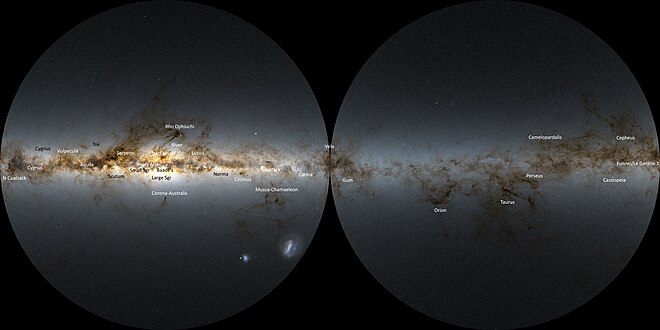
The Great Rift, a series of dark patches in the Milky Way, is more visible and striking in the southern hemisphere than in the northern. It vividly stands out when conditions are otherwise so dark that the Milky Way's central region casts shadows on the ground.[65]Some cultures have discerned shapes in these patches and have given names to these "dark cloud constellations". Members of theIncacivilization identified various dark areas ordark nebulaein the Milky Way as animals and associated their appearance with the seasonal rains.[66][67][68]Australian Aboriginal astronomyalso describes dark cloud constellations, the most famous being the "emu in the sky" whose head is formed by theCoalsack,a dark nebula, instead of the stars.[69]
-
TheEmuin the sky– a constellation defined by dark clouds rather than by stars. The head of the emu is the Coalsack with theSouthern Crossdirectly above. Scorpius is to the left.
-
Inca dark cloud constellations in the Mayu (Celestial River), also known as the Milky Way. The Southern Cross is above Yutu, while the eyes of the Llama areAlpha CentauriandBeta Centauri.
List of dark cloud constellations[edit]
See also[edit]
- Celestial cartography
- Constellation family
- Former constellations
- Lists of stars by constellation
- Constellations listed by Johannes Hevelius
- Constellations listed by Lacaille
- Constellations listed by Petrus Plancius
- Constellations listed by Ptolemy
References[edit]
Footnotes
- ^Astrological signscorrespond to the period of a constellation'sinvisibilitydue to the Sun's transit.
Citations
- ^ab"Definition of constellation".Oxford English Dictionary.Archived fromthe originalon 2 January 2013.Retrieved2 August2016.
- ^"Constellation | Definition, Origin, History, & Facts | Britannica".5 March 2024.
- ^Britton, John P. (2010). "Studies in Babylonian lunar theory: part III. The introduction of the uniform zodiac".Archive for History of Exact Sciences.64(6): 617–63.doi:10.1007/S00407-010-0064-Z.JSTOR41134332.S2CID122004678.
[T]he zodiac was introduced between −408 and −397 and probably within a very few years of −400.
- ^abDelporte, Eugène (1930).Délimitation scientifique des constellations.International Astronomical Union.
- ^abcRidpath, Ian (2018)."Star Tales: The final 88".
- ^"DOCdb Deep Sky Observer's Companion – the online database".Retrieved21 September2018.
- ^"A Complete List of Asterisms".Archived fromthe originalon 29 September 2012.Retrieved21 September2018.
- ^"constellation | Origin and meaning of constellation by Online Etymology Dictionary".etymonline.
- ^"Constellation".Oxford Dictionary of Astronomy.Retrieved26 July2019.
- ^ Harbord, John Bradley; Goodwin, H. B. (1897).Glossary of navigation: a vade mecum for practical navigators(3rd ed.). Portsmouth: Griffin. p. 142.
- ^abcNorton, Arthur P. (1959).Norton's Star Atlas.p. 1.
- ^ Steele, Joel Dorman (1884),The story of the stars: New descriptive astronomy,Science series, American Book Company, p. 220
- ^"Do Constellations Ever Break Apart or Change?".NASA. Archived fromthe originalon 13 October 2011.Retrieved27 November2014.
- ^Koupelis, Theo; Kuhn, Karl F. (2007).In Quest of the Universe.Jones & Bartlett Publishers. p. 369.ISBN978-0-7637-4387-1.
- ^Kovalevsky, Jean; Seidelmann, P. Kenneth (2004).Fundamentals of Astrometry.Cambridge University Press.ISBN978-0-521-64216-3.
- ^Soffel, M; Klioner, S. A; Petit, G; Wolf, P; Kopeikin, S. M; Bretagnon, P; Brumberg, V. A;Capitaine, N;Damour, T; Fukushima, T; Guinot, B; Huang, T.-Y; Lindegren, L; Ma, C; Nordtvedt, K; Ries, J. C; Seidelmann, P. K; Vokrouhlický, D; Will, C. M; Xu, C (2003). "The IAU 2000 Resolutions for Astrometry, Celestial Mechanics, and Metrology in the Relativistic Framework: Explanatory Supplement".The Astronomical Journal.126(6): 2687–706.arXiv:astro-ph/0303376.Bibcode:2003AJ....126.2687S.doi:10.1086/378162.S2CID32887246.
- ^"Resolution C1 on the Definition of a Spectroscopic" Barycentric Radial-Velocity Measure ". Special Issue: Preliminary Program of the XXVth GA in Sydney, July 13–26, 2003 Information Bulletin n° 91"(PDF).IAU Secretariat. July 2002. p. 50.Archived(PDF)from the original on 9 October 2022.Retrieved28 September2017.
- ^What Are the Constellations?,University of Wisconsin,http:// astro.wisc.edu/~dolan/constellations/extra/constellations.html
- ^"Forest for the Trees – Why We Recognize Faces & Constellations".Nautilus Magazine. 19 May 2014.Retrieved3 February2020.
- ^Rey, H. A.(1954).The Stars: A New Way to See Them.Houghton Mifflin Harcourt Publishing.ISBN978-0547132808.
- ^"Best Constellations Season-by-Season: Southern Hemisphere".Star Walk.22 June 2023.Retrieved24 June2024.
- ^Dyer, Alan (19 August 2016)."The Moving Stars of the Southern Hemisphere".The Amazing Sky.Retrieved24 June2024.
- ^abcdefgChartrand, Mark R. (1991).The Audubon Society Field Guide to the Night Sky.New York: A. A. Knopf. pp. 134–162, 405–420.ISBN978-0-679-73354-6.
- ^Sutter, Paul M. (9 October 2020)."The Solar System has a second plane where objects orbit the Sun".Universe Today.Retrieved5 July2024.
- ^"January Constellations".Constellation Guide.Retrieved24 June2024.
- ^"July Constellations".Constellation Guide.Retrieved24 June2024.
- ^Rappenglück, M. (1997). "The Pleiades in the" Salle des Taureaux ", grotte de Lascaux. Does a rock picture in the cave of Lascaux show the open star cluster of the Pleiades at the Magdalénien era (ca 15.300 BC?"".Astronomy and Culture:217.Bibcode:1997ascu.conf..217R.
- ^Cunningham, D. (2011). "The Oldest Maps of the World: Deciphering the Hand Paintings of Cueva de El Castillo Cave in Spain and Lascaux in France".Midnight Science.4:3.
- ^abRogers, J. H (1998). "Origins of the ancient constellations: I. The Mesopotamian traditions".Journal of the British Astronomical Association.108:9.Bibcode:1998JBAA..108....9R.
- ^abSchaefer, Bradley E.(2006). "The Origin of the Greek Constellations".Scientific American.295(5): 96–101.Bibcode:2006SciAm.295e..96S.doi:10.1038/scientificamerican1106-96.PMID17076089.
- ^"History of the Constellations and Star Names – D.4: Sumerian constellations and star names?".Gary D. Thompson.21 April 2015. Archived fromthe originalon 7 September 2015.Retrieved30 August2015.
- ^E. William Bullinger (2015).The Witness of the Stars.eKitap Projesi.ISBN978-963-527-403-1.
- ^Dennis James Kennedy (June 1989).The Real Meaning of the Zodiac.Coral Ridge Ministries Media, Inc.ISBN978-1-929626-14-4.
- ^abRichard H. Allen (2013).Star Names: Their Lore and Meaning.Courier Corp.ISBN978-0-486-13766-7.
- ^"H5906 - ʿayiš - Strong's Hebrew Lexicon (KJV)".Blue Letter Bible.
- ^Lorimer, H. L. (1951). "Stars and Constellations in Homer and Hesiod".The Annual of the British School at Athens.46:86–101.doi:10.1017/S0068245400018359.S2CID192976174.
- ^Marshall Clagett (1989).Ancient Egyptian Science: Calendars, clocks, and astronomy.American Philosophical Society.ISBN978-0-87169-214-6.
- ^Denderah (1825).Zodiac of Dendera, epitome. (Exhib., Leic. square).
- ^Needham, Joseph (1959).Mathematics and the Sciences of the Heavens and the Earth.Science and Civilisation in China. Vol. 3. Cambridge University Press. p. 171.ISBN978-0521058018.
- ^abXiaochun Sun; Jacob Kistemaker (1997).The Chinese Sky During the Han: Constellating Stars and Society.Brill.ISBN978-90-04-10737-3.
- ^abcSelin, Helaine Elise (2008).Encyclopaedia of the History of Science, Technology, and Medicine in Non-Western Cultures.Springer Science & Business Media. p. 2022.ISBN978-1-4020-4559-2.
- ^Sun, Xiaochun (1997).Helaine Selin(ed.).Encyclopaedia of the History of Science, Technology, and Medicine in Non-Western Cultures.Kluwer Academic Publishers. p. 910.ISBN978-0-7923-4066-9.
- ^Schaefer, Bradley E. (May 2005)."The epoch of the constellations on the Farnese Atlas and their origin in Hipparchus's lost catalogue"(PDF).Journal for the History of Astronomy.36/2(123): 167–19.Bibcode:2005JHA....36..167S.doi:10.1177/002182860503600202.S2CID15431718.Archived(PDF)from the original on 9 October 2022.
- ^Norton, Arthur P. (1919).Norton's Star Atlas.p. 1.
- ^"Astronomical Epoch".Archived fromthe originalon 24 July 2011.Retrieved16 July2010.
- ^Swerdlow, N. M. (August 1986). "A Star Catalogue Used by Johannes Bayer".Journal for the History of Astronomy.17(5): 189–97.Bibcode:1986JHA....17..189S.doi:10.1177/002182868601700304.S2CID118829690.
- ^Hogg, Helen Sawyer(1951). "Out of Old Books (Pieter Dircksz Keijser, Delineator of the Southern Constellations)".Journal of the Royal Astronomical Society of Canada.45:215.Bibcode:1951JRASC..45..215S.
- ^Knobel, E. B. (1917).On Frederick de Houtman's Catalogue of Southern Stars, and the Origin of the Southern Constellations.(Monthly Notices of the Royal Astronomical Society,Vol. 77, pp. 414–32)
- ^Dekker, Elly(1987).Early Explorations of the Southern Celestial Sky.(Annals of Science44, pp. 439–70)
- ^Dekker, Elly(1987).On the Dispersal of Knowledge of the Southern Celestial Sky.(Der Globusfreund,35–37, pp. 211–30)
- ^Verbunt, Frank; van Gent, Robert H. (2011).Early Star Catalogues of the Southern Sky: De Houtman, Kepler (Second and Third Classes), and Halley.(Astronomy & Astrophysics530)
- ^Ian Ridpath."Johann Bayer's southern star chart".Star Tales.
- ^Ian Ridpath."Lacaille's southern planisphere of 1756".Star Tales.
- ^ab"The Constellations".IAU –International Astronomical Union.Retrieved29 August2015.
- ^Ian Ridpath."Constellation names, abbreviations and sizes".Retrieved30 August2015.
- ^Ian Ridpath."Star Tales – The Almagest".Retrieved30 August2015.
- ^Ian Ridpath."Nicolas Louis de Lacaille at the Cape".Retrieved4 July2022.
- ^"The original names and abbreviations for constellations from 1922".Retrieved31 January2010.
- ^"Constellation boundaries".Retrieved24 May2011.
- ^Marc Lachièze-Rey; Jean-Pierre Luminet; Bibliothèque Nationale de France. Paris (2001).Celestial Treasury: From the Music of the Spheres to the Conquest of Space.Cambridge University Press. p. 80.ISBN978-0-521-80040-2.
- ^Ian Ridpath."Benjamin Apthorp Gould and theUranometria Argentina".Star Tales.
- ^A.C. Davenhall & S.K. Leggett,"A Catalogue of Constellation Boundary Data",(Centre de Donneés astronomiques de Strasbourg, February 1990).
- ^For example, in theNautical Almanac and Astronomical Ephemeris for the year 1833(Board of Admiralty, London)
- ^Peter Grego (2012)The Star Book: Stargazing Throughout the Seasons in the Northern Hemisphere.F+W Media.
- ^Rao, Joe (11 September 2009)."A Great Week to See the Milky Way".Space.Retrieved5 January2016.
- ^"Night sky".Astronomy.pomona.edu.Archived fromthe originalon 16 December 2010.Retrieved12 March2019.
- ^Dearborn, D.S.P.; White, R.E. (1983). "The" Torreon "of Machu Picchu as an Observatory".Archaeoastronomy.14(5): S37.Bibcode:1983JHAS...14...37D.
- ^Krupp, Edwin (1994).Echoes of the Ancient Skies.Mineola: Dover Publications, Inc. pp. 47–51.ISBN978-0486428826.
- ^Bordeleau, André G. (2013).Flags of the Night Sky: When Astronomy Meets National Pride.Springer Science & Business Media. pp. 124–.ISBN978-1-4614-0929-8.
Further reading[edit]
This "further reading"sectionmay need cleanup.(August 2016) |
Mythology, lore, history, and archaeoastronomy[edit]
- Allen, Richard Hinckley.(1899)Star-Names And Their Meanings,G. E. Stechert, New York, hardcover; reprint 1963 asStar Names: Their Lore and Meaning,Dover Publications, Inc., Mineola, NY,ISBN978-0-486-21079-7softcover.
- Olcott, William Tyler.(1911);Star Lore of All Ages,G. P. Putnam's Sons,New York, hardcover; reprint 2004 asStar Lore: Myths, Legends, and Facts,Dover Publications, Inc., Mineola, NY,ISBN978-0-486-43581-7softcover.
- Kelley, David H. and Milone, Eugene F. (2004)Exploring Ancient Skies: An Encyclopedic Survey of Archaeoastronomy,Springer,ISBN978-0-387-95310-6hardcover.
- Ridpath, Ian.(2018)Star Tales2nd ed., Lutterworth Press,ISBN978-0-718-89478-8softcover.
- Staal, Julius D. W. (1988)The New Patterns in the Sky: Myths and Legends of the Stars,McDonald & Woodward Publishing Co.,ISBN0-939923-10-6hardcover,ISBN0-939923-04-1softcover.
- Rogers, John H. (1998). "Origins of the Ancient Constellations: I. The Mesopotamian Traditions".Journal of the British Astronomical Association.108:9–28.Bibcode:1998JBAA..108....9R.
- Rogers, John H. (1998). "Origins of the Ancient Constellations: II. The Mediterranean Traditions".Journal of the British Astronomical Association.108:79–89.Bibcode:1998JBAA..108...79R.
Atlases and celestial maps[edit]
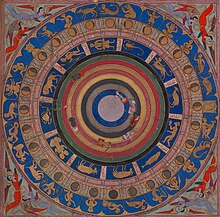
- Becvar, Antonin.Atlas Coeli.Published asAtlas of the Heavens,Sky Publishing Corporation, Cambridge, MA, with coordinate grid transparency overlay.
- Becvar, Antonin. (1962)Atlas Borealis 1950.0,Czechoslovak Academy of Sciences (Ceskoslovenske Akademie Ved), Praha, Czechoslovakia, 1st Edition, elephant folio hardcover, with small transparency overlay coordinate grid square and separate paper magnitude legend ruler. 2nd Edition 1972 and 1978 reprint, Czechoslovak Academy of Sciences (Ceskoslovenske Akademie Ved), Prague, Czechoslovakia, and Sky Publishing Corporation, Cambridge, MA,ISBN0-933346-01-8oversize folio softcover spiral-bound, with transparency overlay coordinate grid ruler.
- National Geographic Society.(1957, 1970, 2001, 2007)The Heavens(1970), Cartographic Division of the National Geographic Society (NGS), Washington, DC, two-sided large map chart depicting the constellations of the heavens; as a special supplement to the August 1970 issue ofNational Geographic.Forerunner map asA Map of The Heavens,as a special supplement to the December 1957 issue. Current version 2001 (Tirion), with 2007 reprint.
- Norton, Arthur Philip. (1910)Norton's Star Atlas,20th Edition 2003 asNorton's Star Atlas and Reference Handbook,edited byRidpath, Ian,Pi Press,ISBN978-0-13-145164-3,hardcover.
- Sinnott, Roger W. and Perryman, Michael A.C. (1997)Millennium Star Atlas,Epoch 2000.0, Sky Publishing Corporation, Cambridge, MA, and European Space Agency (ESA), ESTEC, Noordwijk, The Netherlands. Subtitle: "An All-Sky Atlas Comprising One Million Stars to Visual Magnitude Eleven from the Hipparcos and Tycho Catalogues and Ten Thousand Nonstellar Objects". 3 volumes, hardcover,ISBN0-933346-84-0.Vol. 1, 0–8 Hours (Right Ascension),ISBN0-933346-81-6hardcover; Vol. 2, 8–16 Hours,ISBN0-933346-82-4hardcover; Vol. 3, 16–24 Hours,ISBN0-933346-83-2hardcover. Softcover version available. Supplemental separate purchasable coordinate grid transparent overlays.
- Tirion, Wil;et al. (1987)Uranometria 2000.0,Willmann-Bell, Inc., Richmond, VA, 3 volumes, hardcover. Vol. 1 (1987): "The Northern Hemisphere to −6°", by Wil Tirion, Barry Rappaport, and George Lovi,ISBN0-943396-14-Xhardcover, printed boards. Vol. 2 (1988): "The Southern Hemisphere to +6°", by Wil Tirion, Barry Rappaport and George Lovi,ISBN0-943396-15-8hardcover, printed boards. Vol. 3 (1993) as a separate added work:The Deep Sky Field Guide to Uranometria 2000.0,by Murray Cragin, James Lucyk, and Barry Rappaport,ISBN0-943396-38-7hardcover, printed boards. 2nd Edition 2001 as collective set of 3 volumes – Vol. 1:Uranometria 2000.0 Deep Sky Atlas,by Wil Tirion, Barry Rappaport, and Will Remaklus,ISBN978-0-943396-71-2hardcover, printed boards; Vol. 2:Uranometria 2000.0 Deep Sky Atlas,by Wil Tirion, Barry Rappaport, and Will Remaklus,ISBN978-0-943396-72-9hardcover, printed boards; Vol. 3:Uranometria 2000.0 Deep Sky Field Guideby Murray Cragin and Emil Bonanno,ISBN978-0-943396-73-6,hardcover, printed boards.
- Tirion, Wiland Sinnott, Roger W. (1998)Sky Atlas 2000.0,various editions. 2nd Deluxe Edition, Cambridge University Press, Cambridge, England.
Catalogs[edit]
- Becvar, Antonin. (1959)Atlas Coeli II Katalog 1950.0,Praha, 1960 Prague. Published 1964 asAtlas of the Heavens – II Catalogue 1950.0,Sky Publishing Corporation, Cambridge, MA
- Hirshfeld, Alan and Sinnott, Roger W. (1982)Sky Catalogue 2000.0,Cambridge University Press and Sky Publishing Corporation, 1st Edition, 2 volumes.LCCN81-17975both vols., andLCCN83-240310vol. 1. "Volume 1: Stars to Magnitude 8.0",ISBN0-521-24710-1(Cambridge) andISBN0-933346-35-2hardcover,ISBN0-933346-34-4softcover. Vol. 2 (1985) – "Volume 2: Double Stars, Variable Stars, and Nonstellar Objects",ISBN0-521-25818-9(Cambridge) hardcover,ISBN0-521-27721-3(Cambridge) softcover. 2nd Edition (1991) with additional third author François Ochsenbein, 2 volumes,LCCN91-26764.Vol. 1:ISBN0-521-41743-0(Cambridge) hardcover;ISBN0-521-42736-3(Cambridge) softcover. Vol. 2 (1999):ISBN0-521-27721-3(Cambridge) softcover and 0-933346-38-7 softcover – reprint of 1985 edition.
- Yale University Observatory.(1908, et al.)Catalogue of Bright Stars,New Haven, CN. Referred to commonly as "Bright Star Catalogue". Various editions with various authors historically, the longest term revising author as(Ellen) Dorrit Hoffleit.1st Edition 1908. 2nd Edition 1940 by Frank Schlesinger andLouise F. Jenkins.3rd Edition (1964), 4th Edition, 5th Edition (1991), and 6th Edition (pending posthumous) by Hoffleit.
External links[edit]
- IAU: The Constellations,including high quality maps.
- Atlascoelestis,di Felice Stoppa.
- Celestiafree 3D realtime space-simulation (OpenGL)
- Stellariumrealtime sky rendering program (OpenGL)
- Strasbourg Astronomical Data Center Files on official IAU constellation boundaries
- Studies of Occidental Constellations and Star Names to the Classical Period: An Annotated Bibliography
- Table of Constellations
- Online Text: Hyginus, Astronomica translated by Mary GrantGreco-Roman constellation myths
- Neave PlanetariumAdobe Flash interactive web browser planetarium and stardome with realistic movement of stars and the planets.
- Audio – Cain/Gay (2009)Astronomy CastConstellations
- The Greek Star-Mapshort essay by Gavin White
- Bucur D. The network signature of constellation line figures.PLOS ONE 17(7): e0272270 (2022). A comparative analysis on the structure of constellation line figures across 56 sky cultures.

